Sharrows, the bicycle infrastructure that doesn’t work and nobody wants
San Francisco was poised to make a big improvement in its central transit system: the Better Market Street plan. Market Street is one of the major transit arteries of the city, the route that people ride to commute from the Mission and the Haight to downtown.
It’s also a high-injury corridor, and the city aimed to fix that by creating a grade-separated bike lane and lots of new and improved infrastructure.
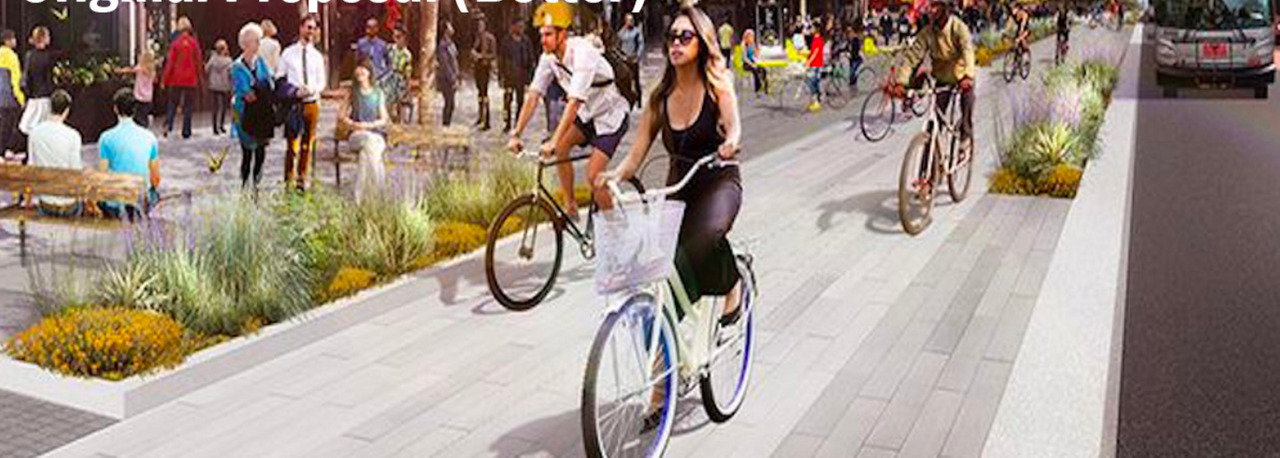
After years of community input and design, the plan was to introduce a separate lane for bikes, sidewalk improvements, separated lanes for buses, and more. It was pretty inspiring.
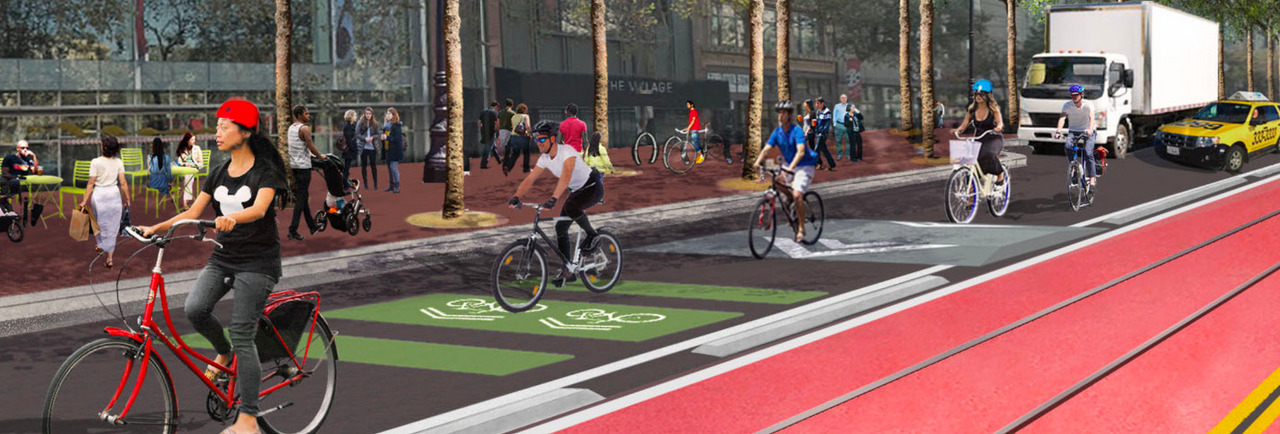
But the budget collapse caused by COVID-19 scaled back the project radically, and now we’re considering sharrows instead of separated bicycle lanes. The plan includes what you see above: a double-wide lane where bicyclists perilously “share the road” with taxis, delivery trucks, and city vehicles. It’s what we call Bummer Market Street.
So I decided to look into the main anti-feature of this plan for cyclists: the sharrow.
What’s a sharrow?
Sharrow is a portmanteau of “shared” and “arrow.” It’s a particular symbol that combines a bicycle icon with an arrow or house icon. Initially, the bicycle was inside the arrow, like it was in a little house, but recently it’s next to the arrow.
Sharrow symbols are painted on streets or applied with thermoplastic decals.
The purpose of a sharrow is to encourage good bicyclist and driver behavior. Sharrows don’t increase legal penalties for drivers or cyclists. They encourage cyclists to take the lane, but cyclists are permitted to do that anyway, on any narrow street. Sharrows are supposed to make motorists aware of cyclists. When drivers kill people in sharrows, there aren’t any additional consequences. The consequences for hitting people with cars are minimal.
Sharrows do constitute class III bikeways, which bring with them higher penalties for illegal parking.
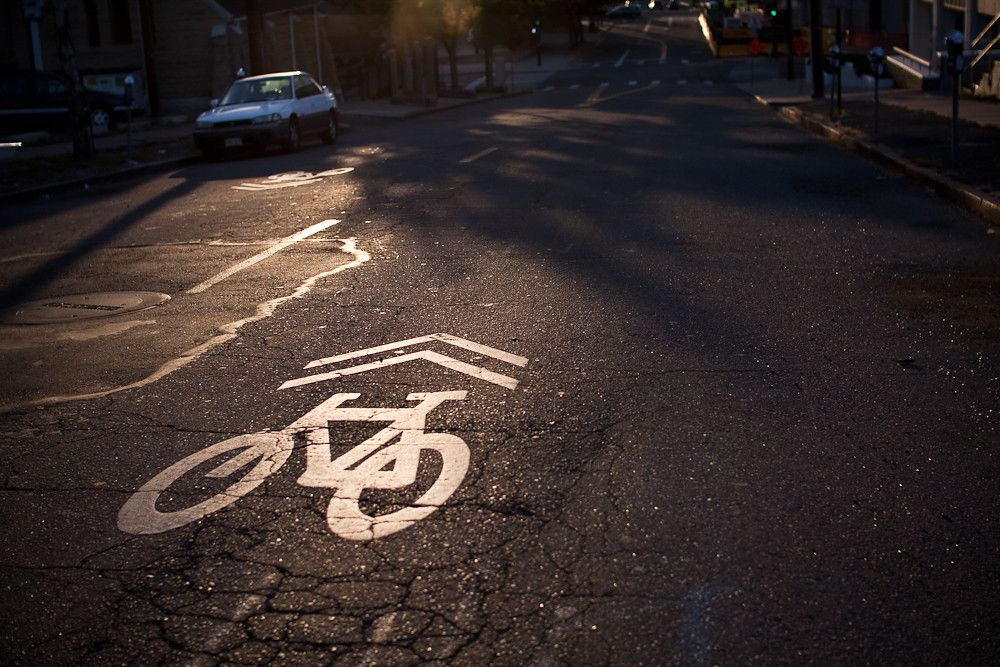
James Mackay invented the sharrow in 1993 in Denver, in hopes that it would legitimize bicycles on the road, encourage cyclists to take the center of the lane, and reduce wrong-way cycling:
I was hoping the shared lane marking would legitimize the presence of bicyclists, reinforce the correct direction of travel and assign lane position, including the correct approach to an intersection and fill an intermediate niche where typical bike lane markings might not necessarily fit.
But I was hoping it overall would provide a step in the right direction towards legitimizing the presence of bicycling and reinforcing bicycle usage. - The Bicycle Story: James Mackay
What are sharrows supposed to do?
This is a really important question, because the answer isn’t simply “to protect people.” San Francisco and many other cities have versions of Vision Zero, the idea that traffic deaths should be reduced to zero.
Sharrows aren’t a general-purpose tool: their applicability and goal is quite specific.
According to the MUTCD, sharrows may be used to:
- Assist bicyclists with lateral positioning in a shared lane with on-street parallel parking in order to reduce the chance of a bicyclist’s impacting the open door of a parked vehicle.
- Assist bicyclists with lateral positioning in lanes that are too narrow for a motor vehicle and a bicycle to travel side by side within the same traffic lane.
- Alert road users of the lateral location bicylists are likely to occupy within the traveled way.
- Encourage safe passing of bicyclists by motorists, and
- Reduce the incidence of wrong-way bicycling.
The purpose of sharrows is thus pretty tied to the problem of dooring, in which drivers don’t look out of their rear-view window before swinging open their doors. Behavioral solutions to dooring, like the Dutch Reach, haven’t caught on in America because it’s America.
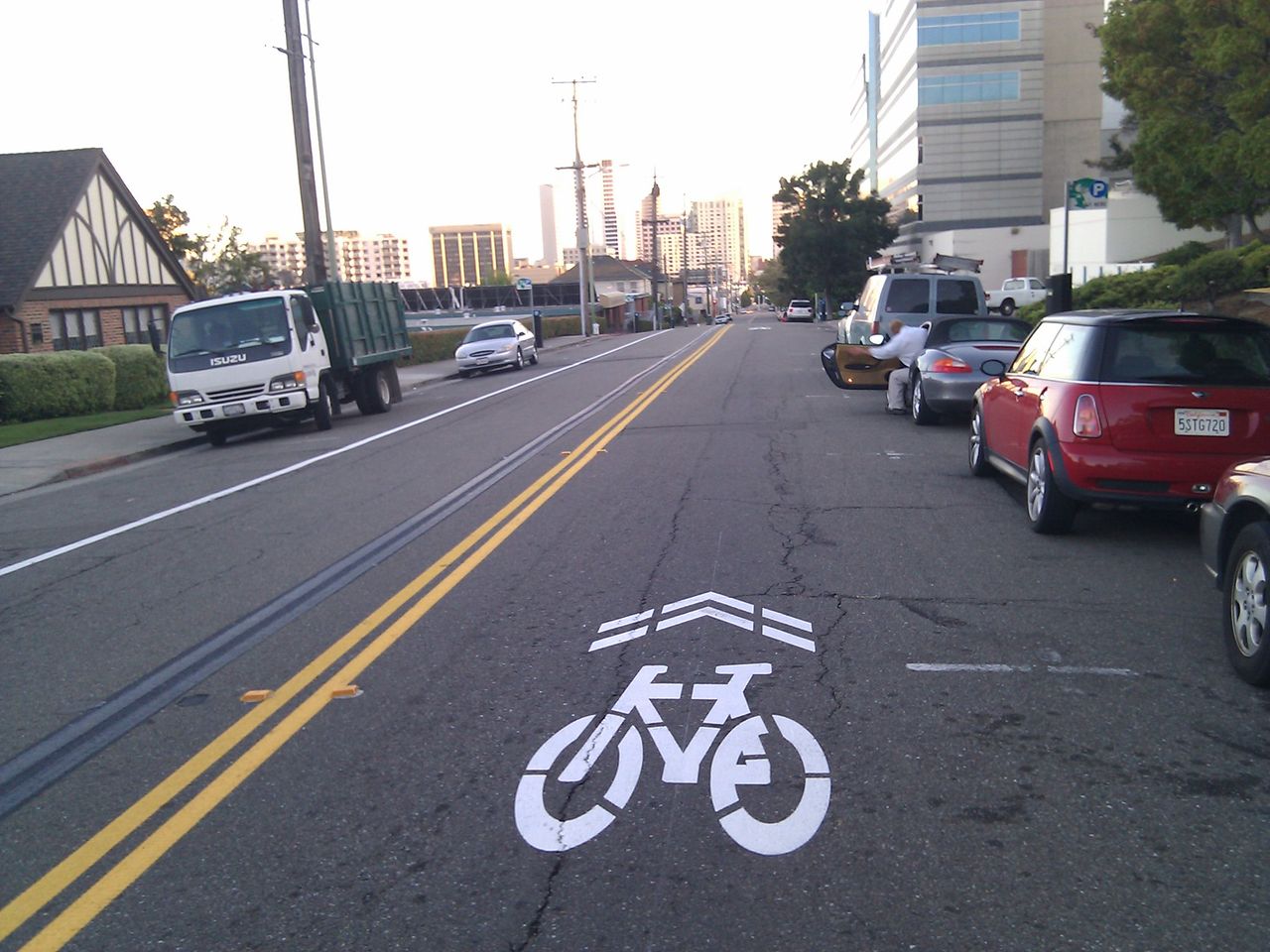
The SFMTA proposed additional use-cases for sharrows: Hills, Narrow Streets, Discontinued Bike Lane due to Roadway Narrowing, Discontinued Bike Lane for Right Turn Lane, Lane Drop for Right Turn Only Lane, Double Turn Lanes, Double Turn Lanes with Bike Box, Route Finding, Roundabouts or Traffic Circles, Along Separated Bikeways, and Space for Only One Bike Lane.
None of this describes the Market Street plan, which would be a double-sharrow in a scenario with no on-street parking. The SFTMA also advises that sharrows are not meant to replace bike lanes, and in this case they are.
Does anyone want sharrows?
Sharrows is are tools for improving combined car traffic and bicycle traffic. It’s apparent from all data that bicyclists do not want car traffic near them.
In a 2009 City of Toronto study, 77% of bicyclists said that to “separate bike lanes from car traffic” would improve cycling “a great deal”, more than any other change. Columbus, Ohio asked in 2008 what infrastructure cyclists would want to see, and 85% of respondents referred to bicycle lanes, with only 76% seeing a benefit to shared-use paths.
Bicycle advocacy organizations also don’t want sharrows: the new Better Market Street plans were immediately panned by the SF Bicycle Coalition.
Do sharrows inform drivers of the presence of bicyclists?
We have a few sources of data here. Let’s look at the San Francisco Shared Lane Marking Study:
The majority of the drivers surveyed claimed not to notice the markings. Since the sample size of drivers was so small, the results do not provide conclusive findings. -p13
Do drivers understand the markings?
Of the motorists that responded, two out of the seven that noticed the markings understood that the marking indicate that they should allow more room for cyclists. p14
There’s a study from Brookline, MA. Do drivers notice markings there?
Of the motorists surveyed, only 21% noticed the markings and were at least 70% confident that the markings indicated a preferred zone for bicycling.
Casual observations from Warren Vermont:
Casual verbal survey of approximately 200 local citizens and 50 bicyclists led to conclusion that bicyclists felt the symbols were too small to be effective and local drivers rarely noticed them. The Vermont DOT decided to not encourage their use, to not replace them, and to not include them in future plans
Do cyclists understand the symbols? Here’s a news report about how they don’t. The city of Fremont had to publish a video about how to use sharrows.
Do sharrows make streets safer?
A striking commonality in the sharrow research is that safety is not clearly measured. Proxies to safety are measured: cyclists riding in the center of the lane, in the right direction, not on sidewalks, and sometimes the distance from cars to bikes. The Texas study does an impressive amount of statistical reasoning about passing events & horizontal positioning on the street. But actual safety is not rigorously measured.
The one study that directly studies the effectiveness of bicycle sharrows for safety is called The Relative (In)Effectiveness of Bicycle Sharrows on Safety Outcomes. It’s a quick read, but the killer line is:
Results suggest that not only are sharrows not as safe as bike lanes, but they could be more dangerous than doing nothing at all.
Do sharrows promote proper horizontal positioning?
This probably isn’t the question you care about, right? Proper horizontal positioning isn’t one of the Vision Zero SF goals. Bicyclists don’t talk that much about proper horizontal positioning. After all, as a cyclist, you can either ride close to parked cars and get doored, or ride too close to moving cars and get hit. A proper horizontal position is just some average of these significant risks.
But nevertheless: proper horizontal positioning is one of the key goals of sharrows. Three of the five goals outlined in the MUTCD are different kinds of proper horizontal positioning. The first goal of San Francisco’s study was horizontal positioning. Most of the sharrow-related data collected is about horizontal positioning.
As Ferenchak & Marshall note, there is mixed evidence for horizontal positioning in correctly-painted sharrows.
Amusingly, though, there are a lot of sharrows that don’t even encourage cyclists to take the center of the lane, because they’re painted in the “door zone”: exactly the area that cyclists are supposed to stay away from.
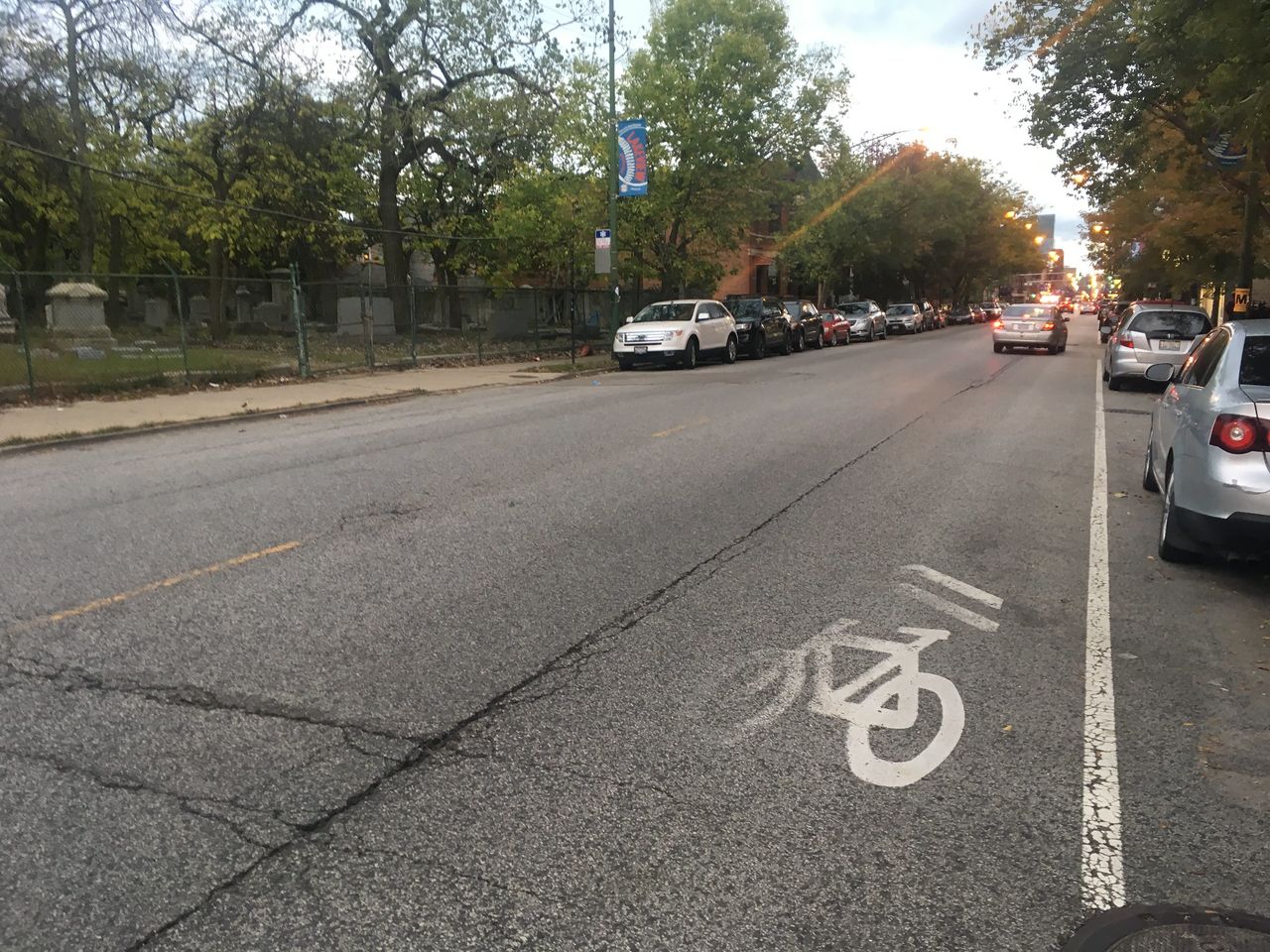
Why don’t sharrows go away?
I’m not the first to point out the uselessness of sharrows. The In(effectiveness) study by Ferenchak and Marshall got airtime on Streetsblog and 99 Percent Invisible. The bicycle coalition immediately opposed San Francisco’s new sharrows. Ferenchak and Marshall expanded their research with additional data.
One defense of sharrows is that they’re part of a larger strategy: why not have all the tools in the toolbox? This is sort of like justifying the addition of some homeopathics in your ambulance medical kit. Sure, you have it now, but it’s not going to do anything.
How sharrows snuck into transportation planning
Sharrows started as a brutal compromise. The creator of the sharrow, James Mackay, essentially said that it was a bare-minimum way to do something for cycling in a city that didn’t want to do anything:
Part of it was the city of Denver’s reluctance to do much of anything for bicycles. So I figured, this would be a less expensive approach versus the conventional bike lane markings. A lot of the agencies don’t want to do anything involving change or spending money for bicycles. I was always under pressure to do less as the Denver bicycle planner.
In this form, as a temporary measure in the evolution of cities away from cars, sharrows made sense.
And sharrows are successful, to some degree, at encouraging cyclists to avoid the “door zone.” And those small, measurable improvements in ‘horizontal positioning’ bought the sharrow’s way into transit device standards.
Then cities started pushed sharrows in all sorts of scenarios that needed bike lanes, not a temporary, toothless symbol on the asphalt. And since they’re cheap and don’t disrupt car traffic, they caught on.
But sharrows have overreached and underperformed. Any cyclist knows that interacting with cars seems dangerous and is dangerous. A sharrow, a subtle symbol without legal weight, doesn’t seem like it’ll help. And there’s no evidence that disproves that common-sense conclusion: cyclists ask for separated lanes because they feel safer and they are safer.
It’s time to relegate sharrows to quiet side streets and let them fade into the asphalt. If you’re in San Francisco, sign the Bummer Market Street Petition to say that we need infrastructure that’s actually focused on safety.
Updates & notes
- Ryan Taylor-Gratzer contacted me about To Live and Ride in LA, his Urban Planning capstone project that suggests that in Los Angeles, the safety benefits of separated bicycle lanes and sharrows were statistically similar. The dataset is relatively limited, but it’s a interesting finding.
- I’ve updated this article about the legal weight of sharrows: they change some of the penalties for illegal parking.
- Different cities have different rules for when you can take the lane. I’ve clarified that taking the lane is legal for narrow streets in most cities, but that depends on the locality.